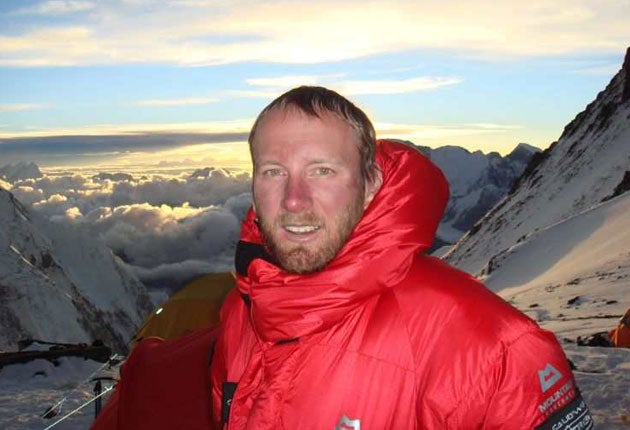The doctor who dropped his trousers on top of the world
That's how Daniel Martin measured his blood oxygen level – and found a more effective treatment for his patients

Your support helps us to tell the story
From reproductive rights to climate change to Big Tech, The Independent is on the ground when the story is developing. Whether it's investigating the financials of Elon Musk's pro-Trump PAC or producing our latest documentary, 'The A Word', which shines a light on the American women fighting for reproductive rights, we know how important it is to parse out the facts from the messaging.
At such a critical moment in US history, we need reporters on the ground. Your donation allows us to keep sending journalists to speak to both sides of the story.
The Independent is trusted by Americans across the entire political spectrum. And unlike many other quality news outlets, we choose not to lock Americans out of our reporting and analysis with paywalls. We believe quality journalism should be available to everyone, paid for by those who can afford it.
Your support makes all the difference.Dropping your trousers near the top of the world's highest mountain in a 20-knot wind and with the temperature at -25C might seem a foolhardy thing to do – even in the interests of science.
Daniel Martin, 35, a member of a team of doctors who climbed Everest, did it – and it guaranteed him a place in the record books.
The anaesthetist and critical care specialist from London had the lowest blood oxygen level ever recorded in a human being – one that was previously thought to be incompatible with life. Yet at the time the sample was taken – from his femoral artery (in the groin) on a tiny ledge 400m beneath the summit of the mountain – he was walking and talking normally, and even took blood samples from his colleagues.
"It was a reasonably unusual thing to do and it attracted a lot of attention from other climbers on the mountain," he admitted yesterday. "But safety was our main priority. It was so exposed and windy on the top [where they had planned to carry out the procedure] that we decided to drop down a bit. We had done it many times before – it was well rehearsed."
The experiment, the results of which are published in the New England Journal of Medicine, was designed to throw light on the care of patients with conditions leading to critically low levels of oxygen such as cystic fibrosis, emphysema, septic shock and "blue baby" syndrome. Dr Martin's blood oxygen level (2.55 kilopascals) was 80 per cent below the normal level (12-14 kPa) and less than half that which would normally trigger urgent admission to intensive care.
Almost 200 people were involved in the expedition, including 60 researchers, who were members of the Caudwell Xtreme Everest team led by Mike Grocott, head of the Centre for Altitude, Space and Extreme Environment Medicine at University College, London. A battery of measurements were taken of the physiological changes that occur when oxygen is scarce but the headline result was the exceptionally low blood levels observed in Dr Martin and three colleagues.
Dr Grocott, who was himself one of the summiteers and had a blood oxygen level only slightly higher than Dr Martin's, said: "It is a unique and extraordinary finding. We don't see these levels in conscious patients, in fact we don't see them at all – only in people in the middle of a cardiac arrest. Yet we were talking fluently on the radio, moving around and performing the procedure."
The climbers had made their final push for the summit from Camp 4, just below 8,000m on the South Col, at 9.30pm on 22 May 2007. After climbing through the night they reached the summit at 6.30am before descending to the Balcony, a tiny ledge and the first flat ground below the summit. There, they removed their oxygen masks, so their lungs could adjust to the low oxygen atmosphere, and erected a small tent. One by one, they crawled into it and unzipped their down suits while a colleague jabbed a needle into their groin.
Once the four blood samples were collected, a Sherpa carried them to the improvised laboratory they had established at Camp 3, making the almost 2,000m descent in an astonishing two hours, where they were analysed.
The explanation for the climbers' survival, despite their low oxygen level, was a combination of acclimatisation – they had spent 60 days at high altitude – and genetics which allowed them to use oxygen more effectively, Dr Grocott said.
"The fascinating thing about this is that it helps us understand how patients tolerate and adapt to hypoxia [low oxygen levels]. The question it raises is, can patients adapt? Some of the interventions we use – giving oxygen, aggressive ventilation – can be harmful. If patients can tolerate lower levels of oxygen so we can back off, then we might cause less harm."
Blood oxygen: How low can you go?
A headache, fatigue and shortness of breath are among the first signs that someone has too little oxygen in their blood. Further reductions can result in dizziness, confusion and feelings of euphoria and/or nausea. The skin also becomes bluer as haemoglobin cells have a darker colour when not carrying oxygen.
The most serious effects are seizures, a coma and ultimately, death. As part of the body's natural response to low levels of oxygen or "hypoxia", it will increase the amount of haemoglobin in the blood.
This is seen during the acclimatisation process at altitude, but as the blood becomes more viscous or "sticky", it forces the heart to work harder to pump it around the body, and can lead to a heart attack.
Join our commenting forum
Join thought-provoking conversations, follow other Independent readers and see their replies
Comments